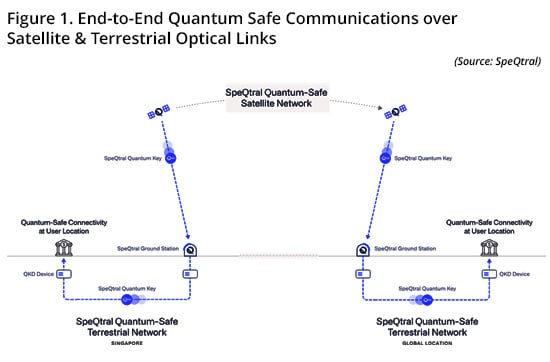By Jake Saunders | 3Q 2024 | IN-7417
Registered users can unlock up to five pieces of premium content each month.
Satellite Steps into the Quantum Realm |
NEWS |
The role of satellites in communications is experiencing a revival in fortunes. Until the mid-1990s, ”satellite” was the preserve of broadcast TV, maritime shipping communications, and intercontinental voice, fax, and some limited data telecommunications. The late 1990s saw the emergence of Mobile Satellite Services (MSS) with Iridium and Globalstar. International business travelers were supposed to be carrying satphones to make their business calls, but standardized 2G Global System for Mobile Communications (GSM) mobile handsets, Subscriber Identity Module (SIM) cards, and national roaming broke that business model. MSS then largely targeted land mobile, yachting, natural resource extraction, and utilities. However, initiatives from The 3rd Generation Partnership Project (3GPP), Apple, and Globalstar, as well as startups Starlink, AST SpaceMobile, etc. have reinvigorated the sector. Satellite is also finding an essential role in hyper-secure communications in the form of quantum-safe communications architectures. SpeQtral, a Singapore-headquartered startup, is positioning itself to play a valuable role in the industrial sector.
Quantum Optical Ground Stations |
IMPACT |
Satellite-based Quantum Key Distribution (QKD) can complement terrestrial QKD. An ABI Insight, “Toshiba and SpeQtral Stand Help Build Singapore’s National Quantum-Safe Network” (IN-7407) also covers fiber-optic QKD. Optical fiber-based QKD transmissions are currently limited to 100 Kilometers (km), whereas satellite-based QKD can be delivered via Low Earth Orbit (LEO), which is typically 550 km. Secure, global communication links can then be established across continents (see Figure 1).

SpeQtral is a spin-out from Singapore’s Centre for Quantum Technologies (CQT). Investors include NUS Technology Holdings, TIS INTEC Group, Xora Innovation, NASA SBIR/STTR, and Batshit Crazy Ventures. Proof of Concept (PoC) was demonstrated in 2019 when a miniaturized polarization entangled photon source was installed into the SpooQy-1 CubeSat (3U* in size). The next stage was to focus on systems integration and scaling up the quantum physics.
Two additional QKD satellites, SpeQtre and SpeQtral-1, are to be launched between 2025 and 2026, respectively. SpeQtre is 12U in size, supports an 8 Centimeter (cm) optical aperture and utilizes the BBM92 protocol (a QKD scheme using polarized entangled photon pairs). SpeQtral-1 is intended to be a commercial tech demonstrator that will further test and validate QKD using BB84, as well as the BBM92 QKD protocols. The optical aperture will be increased to 10 cm. Both satellites only support a single downlink. SpeQtral also has a collaboration with ARQUIMEA (Spain). ARQUIMEA has a high-throughput smallsat platform, BeetleSat. SpeQtral’s space-based QKD will be integrated with ARQUIMEA’s Post-Quantum Cryptography (PQC) technology to serve ARQUIMEA’s customers.
An essential part of the QKD will be the quantum optical ground stations. SpeQtral’s ground station product, TarQis, is integrated into QTD Systems (a New York colocation center) data centers and hands off the quantum safe keys to the quantum secure fiber nodes. It should be noted that the mobile quantum-optical ground station is not “petite.” It is housed in a typical standard 20-foot shipping container, but that does mean the quantum optical ground station can be transported to a new location if required. The container houses the modular quantum receiver unit, the QKD control server, and an optical telescope. Crucially, the quantum optical ground stations can either provide direct access to satellite QKD authentication or serve as a node within a metropolitan fiber-QKD network that can connect to other metropolitan QKD networks. Encryption is supported by symmetric, “one-time pad” and Advanced Encryption Standard (AES) keys that are updated every minute.
Addressing the Challenges |
RECOMMENDATIONS |
Satellite-based QKD is a novel complement to the terrestrial fiber-optic QKD. Satellites can deliver quantum-safe encryption keys to a direct access transceiver or multiple nodes, thereby overcoming the 100 km current limitation of fiber-optic QKD. Even if Research and Development (R&D) improves the fiber-optic QKD integrity distance 10X, or 100X, satellite QKD offers redundancy of key delivery, thereby ensuring there is no single choke point on the ground. While SpeQtral appears to be reasonably well funded and has attracted a cast of complementary partners, its solution has yet to be demonstrably scaled up for major commercial adoption. Furthermore, while the quantum optical ground stations are transportable, they are still very large pieces of equipment. ABI Research does believe that commercialization can further miniaturize the solution.
Sizing the market for QKD is still very much under consideration by ABI Research. As discussed in a previous ABI Insight, “IN-7407,” several mathematicians and physicists, including Feynman and Shor, do consider quantum computing to be a very real future threat to classical encryption schemes. Quantum computing safe algorithms have been posited and preliminarily approved by the National Institute of Standards and Technology (NIST), but some of those algorithms may still fall by the wayside. Symmetric key encryption is advocated to be quantum safe, and being able to detect active “snooping” of transmissions should potentially help protect those valuable transmissions.